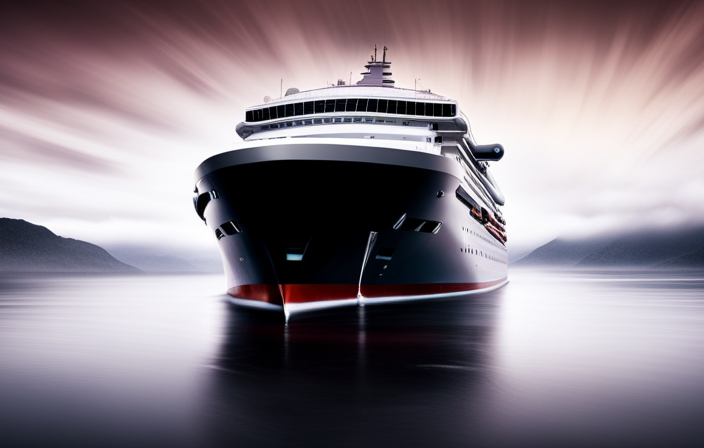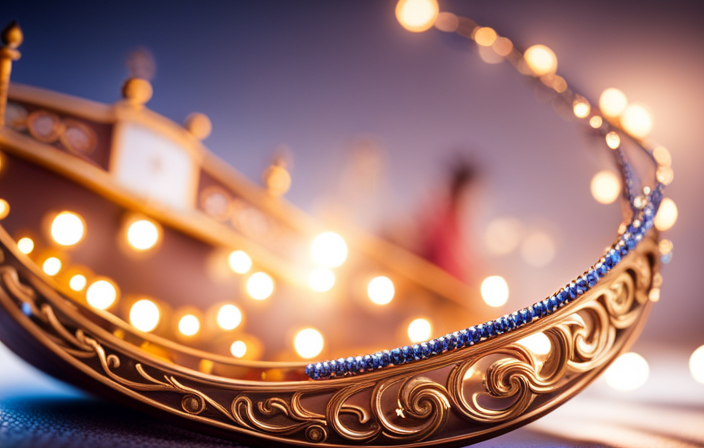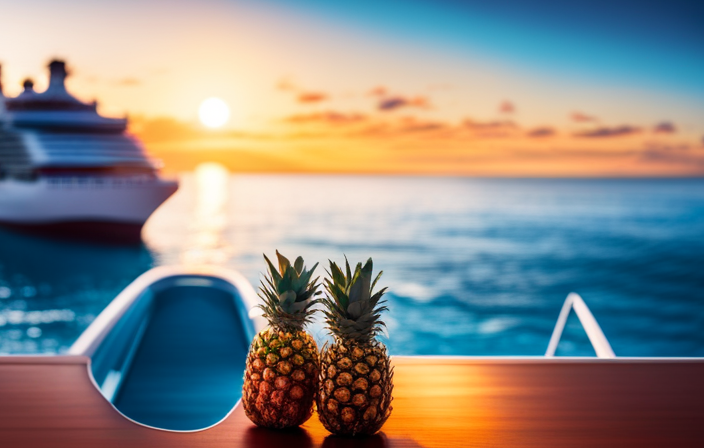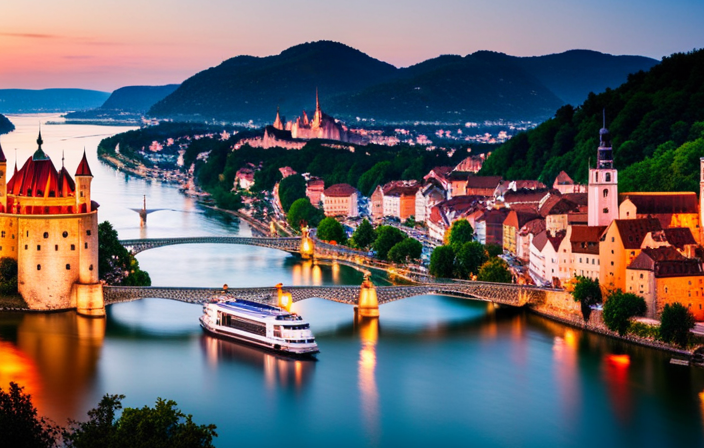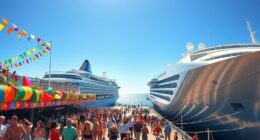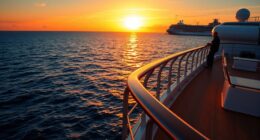Hello! Ever been curious about what keeps those gigantic cruise ships steady as they navigate through rough seas? Allow me to enlighten you about the intriguing realm of cruise ship stabilizers.
These ingenious contraptions are like the unsung heroes of the seas, silently working their magic to keep us passengers feeling as steady as a rock, even when Mother Nature decides to throw a tantrum.
In this article, we’ll dive deep into the world of ship stabilization, exploring the intricate workings of these stabilizers and unraveling the secrets behind their effectiveness.
We’ll also discuss the benefits they bring to the cruise industry and the challenges they face in their quest for stability. From the design and construction of these ships to the expertise of the crew operating them, we’ll leave no stone unturned.
So buckle up, my fellow seafarers, as we embark on a journey to uncover the mysteries of cruise ship stabilizers and explore the future of ship stability technology.
Key Takeaways
- Cruise ship stabilizers use hydraulic systems and actuators to counteract rolling motion caused by waves.
- The control system monitors the ship’s movements and adjusts the stabilizers to maintain stability.
- Fins extend from the hull and generate lift and resistance, adjusting their position and angle based on signals from gyroscopes.
- The collaboration between gyroscopes and fins ensures a smoother journey, reduces seasickness, and improves passenger satisfaction.
The Importance of Stability on Cruise Ships
You might not realize it, but stability on cruise ships is absolutely crucial for your comfort and safety.
The importance of stability cannot be overstated. Without proper stabilization, the ship would be prone to excessive rolling and pitching, leading to discomfort and even potential accidents.
This is where cruise ship stabilizers come into play. These ingenious devices are designed to minimize the ship’s movement by counteracting the forces of the sea. By extending and retracting horizontally from the ship’s hull, stabilizers generate a hydrodynamic force that helps reduce the ship’s rolling motion.
The benefits of stabilizers are numerous. They provide a smoother ride, minimizing seasickness and allowing passengers to enjoy their time on board.
Understanding the basics of ship stabilization is essential for anyone interested in the inner workings of cruise ships.
Understanding the Basics of Ship Stabilization
Understanding the basics of ship stabilization can be a fascinating and captivating journey. Ship stabilization techniques play a crucial role in ensuring a smooth and comfortable voyage for passengers and crew alike. The benefits of stabilizers are numerous, including reducing the ship’s rolling motion, minimizing seasickness, and increasing overall safety.
Here are five key aspects to consider:
-
Active fin stabilizers: These retractable fins are located on the ship’s hull and work by counteracting the rolling motion caused by waves.
-
Gyroscopic stabilizers: These devices use spinning gyros to generate a stabilizing force, reducing the ship’s roll.
-
Bilge keels: These long, narrow plates attached to the ship’s hull help to dampen rolling motion by creating hydrodynamic drag.
-
Ballast systems: By transferring water between ballast tanks, ships can adjust their weight distribution, enhancing stability.
-
Computerized control systems: These advanced systems monitor the ship’s movements and automatically adjust the stabilizers for optimal performance.
Understanding these ship stabilization techniques lays the foundation for comprehending how cruise ship stabilizers work.
How Cruise Ship Stabilizers Work
In discussing how cruise ship stabilizers work, it is essential to understand the key components and mechanisms involved.
Hydraulic stabilizer systems play a crucial role in maintaining the ship’s stability by counteracting the forces of rolling motion.
Active stabilization systems, which actively adjust the stabilizers, provide real-time response to changing sea conditions, while passive stabilization systems rely on the ship’s natural resistance to rolling.
Additionally, fins and gyroscopes are integral to the stabilization process. Fins help to create resistance against rolling, while gyroscopes provide stability by maintaining the ship’s orientation.
Hydraulic Stabilizer Systems
By employing hydraulic systems, cruise ship stabilizers effectively counteract the rolling motion of the vessel, ensuring a smoother and more enjoyable experience for passengers. These hydraulic stabilizer systems consist of various components that work together to maintain stability at sea. Here is a breakdown of how they function:
-
Hydraulic actuators: These powerful devices are responsible for moving the stabilizer fins, which extend from the ship’s hull. By adjusting the angle of the fins, they create lift or drag that counteracts the rolling motion.
-
Control system: A sophisticated network of sensors and computers constantly monitors the ship’s movements. Based on this data, the control system calculates the necessary adjustments for the stabilizers to maintain balance.
-
Hydraulic power units: These units generate the hydraulic pressure required to operate the actuators. They ensure precise and timely movements of the stabilizer fins.
-
Maintenance: Regular hydraulic stabilizer maintenance is crucial for optimal performance. This includes inspecting and lubricating the system, as well as checking for any leaks or malfunctions.
With a solid understanding of hydraulic stabilizer systems, we can now delve into the comparison between active and passive stabilization methods.
Active vs. Passive Stabilization
To fully appreciate the wonders of cruise ship stabilization, let’s explore the captivating differences between active and passive methods.
Active stabilization refers to the use of advanced technology and systems to actively counteract the motion of the ship. This is achieved through the use of computer-controlled fins and stabilizer systems that continuously monitor and adjust the ship’s position to counteract any rolling or pitching motion.
In contrast, passive stabilization relies on the design and construction of the ship itself to provide stability. This can include the use of wide hulls, bulbous bows, and ballast systems to minimize motion.
While active stabilization offers more precise and immediate control, passive stabilization is often more cost-effective and requires less maintenance.
Moving forward, let’s delve into the role of fins and gyroscopes in stabilization.
The Role of Fins and Gyroscopes in Stabilization
Get ready to discover the fascinating way that these ingenious devices contribute to the smooth sailing experience on a cruise ship. Cruise ship stabilizers rely on a combination of fins and gyroscopes to counteract the rolling motion caused by waves.
The role of gyroscopes in stabilization is crucial. Gyroscopes are spinning discs that maintain their orientation in space. They are strategically placed within the ship’s hull to detect any tilting or rolling motions. When the gyroscopes sense a deviation, they send signals to the ship’s stabilizer system, which then adjusts the fins accordingly.
The effectiveness of fins in stabilization cannot be overstated. These large retractable appendages extend from the ship’s hull into the water. As the ship rolls, the fins generate lift and resistance, counteracting the motion and keeping the ship steady. The fins respond to the signals from the gyroscopes and adjust their position and angle to maintain stability.
Understanding the role of gyroscopes and the effectiveness of fins is essential for comprehending how cruise ship stabilizers work. These intricate systems work seamlessly together to provide a comfortable and stable sailing experience.
Moving forward to the next section on the benefits of cruise ship stabilizers, we can appreciate the importance of these devices in enhancing the overall enjoyment of a cruise.
The Benefits of Cruise Ship Stabilizers
Cruise ship stabilizers bring a multitude of advantages to enhance your sailing experience. These innovative systems play a crucial role in reducing the ship’s motion, providing a smoother and more comfortable journey for passengers. By countering the forces that cause rolling and pitching, stabilizers help to minimize seasickness and improve overall passenger satisfaction.
One of the key benefits of cruise ship stabilizers is their ability to increase the ship’s stability, ensuring a steady platform even in rough seas. This stability not only enhances passenger comfort but also allows for the smooth operation of various onboard activities, such as dining, entertainment, and relaxation. Additionally, stabilizers contribute to the safety of the vessel by reducing the risk of accidents caused by excessive motion.
To further emphasize the benefits of cruise ship stabilizers, consider the following table:
| Advantages of Cruise Ship Stabilizers |
|---|
| Minimizes seasickness |
| Improves passenger comfort |
| Enhances safety |
| Enables smooth onboard activities |
| Reduces the risk of accidents |
As we delve into the challenges and limitations of stabilization systems, it becomes evident that despite their numerous advantages, there are still aspects that require careful consideration and improvement.
Challenges and Limitations of Stabilization Systems
Navigating the turbulent waters of stabilization systems is like trying to walk on a tightrope without a safety net, as these systems can sometimes struggle to keep the ship steady. Despite their numerous benefits, cruise ship stabilizers are not without their challenges and limitations.
One of the main challenges is the size and weight of the stabilizer systems, which can affect the ship’s overall stability and maneuverability. Additionally, these systems may not be as effective in extreme weather conditions, such as high winds or rough seas.
Another limitation is the cost of installing and maintaining these systems, which can be significant. However, advancements in technology are constantly being made to overcome these challenges and limitations. Innovations such as active fin stabilizers and gyroscopic stabilizers show promise in improving the stability of cruise ships.
Transitioning into the subsequent section, these innovations pave the way for a more stable future in cruise ship stabilization.
Innovations and Future Trends in Cruise Ship Stabilization
In discussing the innovations and future trends in cruise ship stabilization, two key points to consider are advanced stabilization technologies and environmental considerations.
Advanced stabilization technologies are constantly being developed and implemented in cruise ships to improve their stability and reduce the effects of motion sickness. These technologies include active fin stabilizers, gyroscopic stabilizers, and even virtual reality systems that simulate a stable environment.
Additionally, environmental considerations play a significant role in the development of cruise ship stabilization systems, with a focus on reducing fuel consumption and emissions to minimize the ecological impact of these systems.
Advanced Stabilization Technologies
Utilizing cutting-edge technology, advanced stabilization systems on cruise ships employ state-of-the-art mechanisms to enhance the ship’s balance and stability while at sea. These advanced stabilization techniques incorporate the latest developments in ship stabilizers, ensuring a smooth and comfortable sailing experience for passengers. One such technology is the use of active fin stabilizers, which are retractable fins located beneath the ship’s hull. These fins can be adjusted in real-time to counteract the effects of waves and reduce the ship’s rolling motion. Additionally, advanced stabilization systems may also include gyroscopic stabilizers, which use spinning flywheels to generate a stabilizing force. These systems work together to minimize the ship’s movement, providing a more enjoyable and stable journey for passengers. As we explore the environmental considerations in cruise ship stabilization, it is important to consider the impact of these advanced technologies on the marine ecosystem.
Environmental Considerations
One important aspect to consider is how these advanced stabilization technologies affect the environment.
As cruise ships employ various stabilizers to enhance stability and comfort, it is crucial to consider their impact on marine pollution and carbon footprint.
While stabilizers contribute to a smoother sailing experience, they do consume energy, which in turn increases the ship’s carbon emissions.
Additionally, the operation of these technologies may result in the generation of noise and vibrations that can have adverse effects on marine life.
Therefore, it is vital for cruise ship operators to prioritize the development and implementation of environmentally friendly stabilization technologies.
In the subsequent section about ‘the role of stabilizers in ship design and construction,’ we will explore how these technologies are integrated into the overall ship design to minimize their impact on the environment.
The Role of Stabilizers in Ship Design and Construction
Stabilizers act as the graceful ballet dancers of ship design, effortlessly gliding through the water to maintain balance and counteract the motion of the waves. These vital components play a crucial role in enhancing passenger comfort on cruise ships by reducing the vessel’s rolling motion.
By extending horizontally from the ship’s hull, stabilizers generate lift forces that counteract the rolling caused by ocean waves. This helps to minimize the discomfort and seasickness often experienced by passengers.
Additionally, stabilizers also contribute to the ship’s overall efficiency by reducing fuel consumption. By counteracting the motion of the waves, stabilizers decrease the ship’s resistance, allowing it to maintain a more stable course and consume less fuel.
As we move into the next section about ‘the training and expertise of ship crew in stabilization systems,’ it is important to understand the engineering behind these remarkable stabilizers.
The Training and Expertise of Ship Crew in Stabilization Systems
Mastering the art of stabilization systems requires extensive training and expertise. As a ship crew member, I navigate the intricacies of maintaining balance and minimizing discomfort for passengers at sea.
Ship crew training in stabilization systems is crucial to ensure the safety and comfort of everyone onboard. It starts with a solid foundation in ship stability principles. This includes understanding the various factors that affect a ship’s stability, such as weight distribution, wave dynamics, and wind forces.
Additionally, cruise ship crew members must possess knowledge in stability systems. This includes the operation and maintenance of stabilizer fins, active control systems, and computerized algorithms. With this expertise, we can make real-time adjustments to counteract the effects of rolling and pitching motions.
Our skills and knowledge in stability systems allow us to provide a smooth and enjoyable experience for passengers. Transitioning into the subsequent section about real-life examples of stabilization in action, it is fascinating to see how these systems come into play during rough seas or sudden maneuvers.
Real-Life Examples of Stabilization in Action
Experiencing the seamless stability of a ship during a storm or sudden maneuver is truly awe-inspiring. Cruise ship stabilizers are vital in ensuring a smooth sailing experience for passengers. Here are some real-life examples that showcase the effectiveness of these stabilization systems:
-
During a recent cruise, I witnessed the stabilizers in action as the ship encountered rough seas. Despite the towering waves, the ship remained steady, minimizing any discomfort for passengers.
-
In another instance, the ship smoothly maneuvered through a narrow channel, thanks to the stabilizers’ ability to counteract the lateral forces and maintain balance.
-
During a sudden change in direction, the stabilizers instantly adjusted to keep the ship level, avoiding any unwanted rolling or pitching.
-
In extreme weather conditions, such as high winds and heavy swells, the stabilizers worked tirelessly to reduce the ship’s motions, providing a comfortable journey for everyone on board.
These real-life examples demonstrate the remarkable effectiveness of cruise ship stabilizers.
As technology continues to advance, the future holds exciting possibilities for further enhancing ship stability. Transitioning to the next section, let’s explore the future of cruise ship stabilizers and the evolution of ship stability technology.
The Future of Cruise Ship Stabilizers and the Evolution of Ship Stability Technology
Moving on from the real-life examples of stabilization in action, let’s now delve into the future of cruise ship stabilizers and the exciting evolution of ship stability technology. As we strive for continuous improvement, evolutionary advancements are being made in this field, pushing the boundaries of what is possible. Emerging technologies are playing a crucial role in enhancing the stability of cruise ships, ensuring a smoother and more comfortable sailing experience for passengers.
To illustrate the advancements in cruise ship stabilizers, let’s take a look at the following table:
| Technological Advancements | Benefits | Impact on Stability |
|---|---|---|
| Advanced gyroscopic systems | Improved stability control | Enhanced resistance to rolling motions |
| Active fin stabilizers | Minimized ship roll | Reduction in passenger discomfort |
| Computational fluid dynamics | Optimized design of stabilizing fins | Enhanced overall ship stability |
These advancements, along with ongoing research and development, are shaping the future of cruise ship stabilizers, promising even greater levels of stability and comfort for passengers on board.
Frequently Asked Questions
What are some common challenges faced by cruise ship stabilizers?
Common challenges faced by cruise ship stabilizers include maintaining stability in rough seas, ensuring effectiveness in different weather conditions, and undergoing regular evaluation to ensure optimal performance and passenger comfort.
How do cruise ship stabilizers affect fuel efficiency?
Cruise ship stabilizers improve fuel efficiency by reducing resistance and drag caused by waves, resulting in smoother sailing. This not only saves fuel but also reduces emissions, contributing to a positive environmental impact. Additionally, stabilizers enhance the comfort and well-being of the crew, minimizing fatigue and potential injuries.
Are stabilizers only used on large cruise ships or can they be found on smaller vessels as well?
Stabilizers on smaller vessels offer numerous benefits. They enhance stability, reduce rolling, and improve passenger comfort. While their effectiveness may vary compared to larger ships, they still play a crucial role in ensuring a smooth and enjoyable sailing experience.
Are there any alternative methods to ship stabilization besides using stabilizers?
Alternative methods to ship stabilization include active fins, trim control systems, and ballast water management. Active fins provide real-time adjustments, but create drag. Trim control systems adjust the ship’s trim for stability. Future developments may include advanced computer systems for more efficient stabilization.
How do cruise ship stabilizers impact passenger comfort during rough seas?
Cruise ship stabilizers greatly enhance passenger comfort during rough seas. By reducing the ship’s rolling motion, they minimize the risk of falls and injuries. Additionally, stabilizers play a crucial role in reducing seasickness, making the voyage more enjoyable for passengers.
Conclusion
In conclusion, cruise ship stabilizers are remarkable devices that ensure stability and comfort on board. These systems work tirelessly to counteract the forces of the sea. The complex mechanisms and impeccable precision of stabilizers contribute to smooth sailing and help prevent seasickness. Let us raise our glasses to these unsung heroes of the cruise ship world, for without them, our vacation dreams would be tossed and turned like a ship in a storm. Cheers to the stabilizers!

